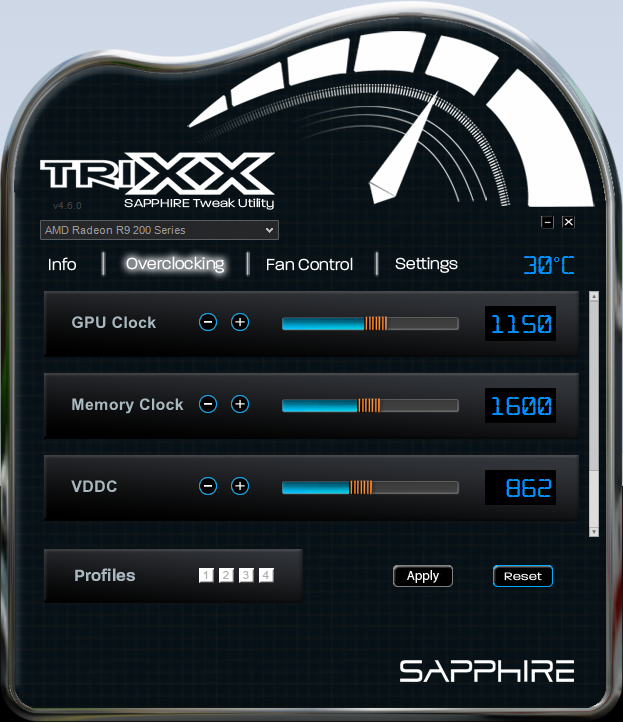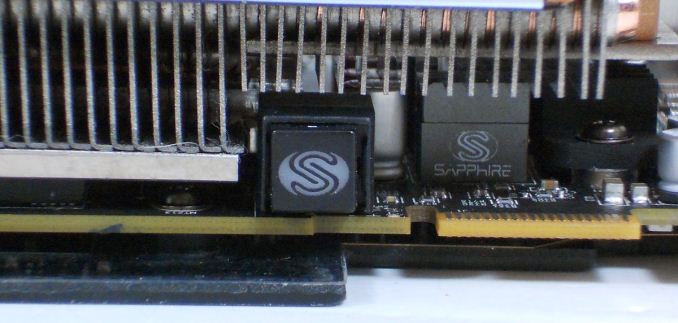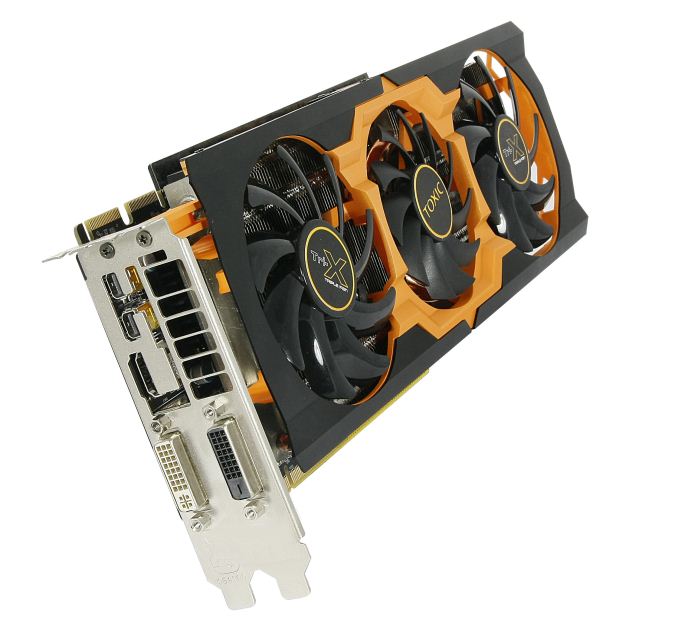The Sapphire R9 280X Toxic Review
by Ryan Smith on October 10, 2013 8:00 AM EST- Posted in
- GPUs
- Radeon
- Sapphire
- Tahiti
- Radeon 200
Meet The Sapphire R9 280X Toxic, Cont
Moving on to the electronics of the 280X Toxic, Sapphire has equipped the card with their standard high-end “black diamond” solid chokes and solid capacitors. The use of solid state parts on high end cards is typical for everyone these days, so about the only thing that sets Sapphire apart here is the physical design of their chokes, which uses a number of fins to give their tops additional surface area for a heatsink-like heat dissipation effect.
Like some of the other 280X cards we’ve seen, Sapphire has gone with a 10 phase power implementation on their card to give the card more headroom on the power side, outfitting the card with 8 power phases for the GPU as opposed to the typical 5 phases, and the same 2 phase memory/IO setup. Sapphire is operating the card at an above-spec voltage of 1.256v, so the additional phases are crucial in delivering the higher wattage this card draws on to operate.
Also found on the card is a push-button BIOS selection switch for dual VBIOS functionality. For the retail cards one VBIOS will be for use with standard PC BIOS systems, while the second VBIOS will be for UEFI systems. Our press sample didn’t come with the UEFI VBIOS so we weren’t able to test that for this article. Of course the presence of the second BIOS also allows for safer BIOS modding, for those inclined to do that.
Overall, and with an immediate preface that I don’t have any reason to believe the shipping retail cards will be like this, the build quality on our press sample was relatively poor. As is sometimes the case this card was assembled by hand in order to get it to us early enough ahead of the retail shipments for today’s review. These hand assembled cards are hit and miss and in this case ours was a miss, with a pair of shroud screws having come out of place. The end result being that the tail end of the shroud (farthest from the GPU) wasn’t secured and could easily move several millimeters away from the card.
This didn’t impact our testing in any way, and we were able to fix the problem after fully disassembling the card. But it does highlight the fact that the only real weakness in Sapphire’s design is that the shroud isn’t mounted to the heatsink/PCB in enough points, particularly towards the rear. The retail cards will have the same limited number of mounting points, but given what’s happened in the past with other dodgy hand-built press samples I’m not expecting those cards to have the screw problem, though it is something we’ll be keeping an eye on as these cards hit retail.
Meanwhile overclockers will want to pay note that overclocking options on the 280X Toxic will be limited. The card has solid power delivery, however there isn’t any voltage control on the card – Sapphire Trixx, MSI Afterburner, and Asus GPU Tweak are unable to set a different voltage – so you can only overclock it as far as the default voltage will take you. In that respect Sapphire has clearly designed the card for stock operation as opposed to satisfying that end-user overclocking itch.
While we’re on the subject of overclocking, Sapphire’s Trixx overclocking utility works with this card out of the box, but unfortunately it hasn’t changed much since the last time we’ve seen it. It’s still competent at overclocking, but it lacks any good monitoring features, so anyone intending to chase overclocking will probably want to stick to Afterburner for this.

Moving on, let’s briefly talk about I/O and other connectivity. Sapphire has opted for the Radeon standard of 1x DL-DVI, 1x SL-DVI (physically DL-DVI), 1x HDMI, and 2x Mine DisplayPort 1.2 for connectivity, so the card should be able to easily drive anything thrown at it. Meanwhile at the top of the card are a pair of 8pin PCIe power sockets; though the card shouldn’t need more than 300W at stock, given the amount of power we do see it draw and the PowerTune limits when overclocked, the additional 75W offered by the second 8pin connector is a solid idea in this case.
Finally, let’s quickly talk warranties and pricing. Sapphire is offering their standard 2 year warranty with this card, which although not particularly short does make it the shortest among all of the 280X cards we’ve looked at so far. Meanwhile pricing is what you’d expect for such a heavily overclocked card, with Sapphire releasing the card at $349, a full $50 (17%) higher than the MSRP for a stock 280X. The card is quite a bit faster than a standard 280X – 13% faster on average – so Sapphire isn’t out of line here, but they won’t be improving on the price/performance ratio over standard cards.













84 Comments
View All Comments
ShieTar - Monday, October 14, 2013 - link
Test results depend strongly on the case used for the testing and also on the geometry of the measurement room, most importantly the distance between the card and the microphone.I seem to remember that AT is testing with the card in an open setup, while kitguru are referring to a closed chasis in the review you have linked.
Ryan Smith - Monday, October 14, 2013 - link
For general testing we're in a closed setup, specifically a NZXT Phantom 630 (as listed in our test apparatus section).Also, keep in mind that our intention here is for these results to be relative, not absolute. We're primarily concerned with which card is louder/quieter and by how much. The problem with absolute results is that more so than any other attribute we test, it varies heavily with the environment, both with regards to the case and the room the computer is setup in.
FuriousPop - Thursday, October 10, 2013 - link
hhmmmmm.........not that impressive from the red team and im guessing the 290X will just be a supe'd up 280X (hopefully not). but i think i'll be sticking with my cfx 7970's (asus top versions)... but if the green team drop the 770/780's in price then i do believe those will be a price - performance wise bargin... i guess we must still wait for the 290X to come.....and see...Mombasa69 - Monday, October 14, 2013 - link
"hhmmmmm.........not that impressive from the red team" LMAO! It's near 30% faster than a standard 7970 and is full DX11.2... numb nuts. Even beats a 780 on half the benchmarks and the true Radeon optimized games designed for the new Radeon using consoles aren't even out yet.All this for only £260-£280!
jenesis33 - Thursday, October 10, 2013 - link
NV already stated they are not dropping price for GTX 770 / 780.So yeah. i understand this is not impressive for ppl arleady have 7970 and etc.
But for some1 like me who is upgrading from a GTX 560, i think it's great news.. Awesome performance for price...
FuriousPop - Thursday, October 10, 2013 - link
i disagree - for those in your position i would rather upgrade to a gtx670 or 7850 (or there abouts), save those extra bucks for early next year or better yet, stick with what you got now and purchase something early-mid next year. i only got my 7970's late last year, before that i had a 4870 for as long as i can remember (tried 2xgtx670's but 1 of them DOA, hence 7970 the only choice).prices will always drop - my thoughts have always been whats the best value not what is the best performer out there.... and with this 280X power hunger mode on, i don't see the 290X being any better in that department therefore requiring more out of your whole system to utilize the full performance of it, to which i don't think its worth it....but hey, go nuts if you like!
Yeoman1000 - Friday, October 11, 2013 - link
You can always wait, but you can never really win with tech. In the uk, 7850 is about £110-130. 7970 can be had for £210-230. Bear in mind the 3gb & 384-bit...for peeps in the uk at least it seems like 'old' 7970 stock is the same excellent value as a 7850, for now at least it seems you can't lose.commissar0617 - Saturday, October 12, 2013 - link
WHO CARES ABOUT POWER CONSUMPTION? a 200w power draw difference will mak minimal difference if your power bill....ShieTar - Monday, October 14, 2013 - link
For a serious gamer (1000 hours a year at least), with assumed electricity cost of 0.20$ / kWh, thats already 40$ a year. Keep in mind that people who need to watch that kind of money are often students, some of them playing (and/or working) more than 1000 hours a year, and also keep in mind that some of the international readers of AT may also pay 0.50$/kWh, and you may also be looking at 200$ or more cost per year. Most people won't call that minimal.That aside, I personally do not worry about 60$ electricity per year, but 200W additional draw will lead to a noticeable increase in noise, and that I do care about a lot. So I most definitely care to see those numbers in any review.
Mombasa69 - Monday, October 14, 2013 - link
I'll be upgrading my 3 way 570's for 2 of these Sapphire Radeon R9 280X Toxic's, it even comes with a great oc utility, a small tweak and it'll be as good as the over-priced 780.